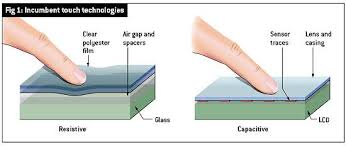Comparing Resistive Touch and Capacitive Touch
Blaze Display Technology Co., Ltd. | Updated: Nov 27, 2018
When choosing between resistive and capacitive touch, be sure to know where as well as how the display will be used. Different applications call for different touch technology.
How does resistive touch work?
Resistive touchscreens use a relatively simple technology. A resistive touchscreen comprises two flexible sheets with an air gap between them. When the screen is touched, the sheets make contact. Then the touch location is calculated based on voltages using and an ADC. Read more about how to implement a resistive touchscreen.
Resistive touchscreens register touches made with a finger (even if gloved), stylus, pencil eraser or anything with an end blunt enough not to damage the screen. Most ATMs, card readers at the grocery store, and older home electronics use resistive touch sensing.
Because resistive touchscreens are relatively simple and require only four lines to sense touch, the lines connecting the touchscreen to the microcontroller are often incorporated into the main display tail, meaning only one connection between the display module and the controller are needed.
How does capacitive touch work?
Capacitive touchscreens are a little more complicated. Capacitive touchscreens work by registering a change in an electrostatic field on the screen when touched with an adequately capacitive object, like a finger. Gloved fingers or a stylus may be used, but they must have conductive materials to simulate a bare finger.
As capacitive touchscreens require a controller and more lines, the tail of a capacitive touchscreen is usually separated from the main display tail.
Advantages and Disadvantages of Resistive Touch and Capacitive Touch
Beyond the methods of obtaining a touch, there are advantages and disadvantages that must be considered when choosing between a resistive touchscreen and a capacitive touchscreen. In short, resistive touchscreens are less expensive and work well in outdoor applications, but do not age well (they can get scratched, and become hazy with age) and can only register a single touch. Capacitive touchscreens use a glass top layer so they maintain more of the display’s brightness. Plus, capacitive touchscreens can support multiple touches and gestures. The main draw backs for capacitive touchscreens are the higher cost and lower tolerance of environmental factors.


